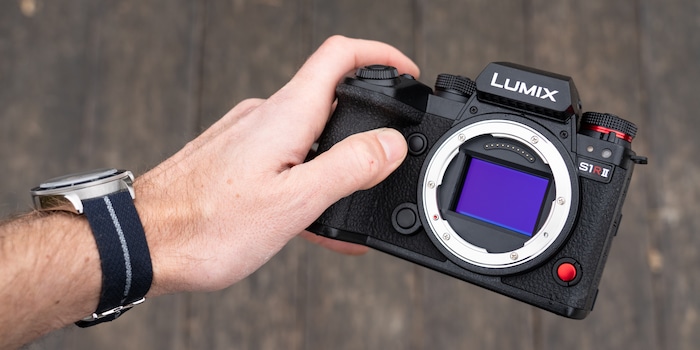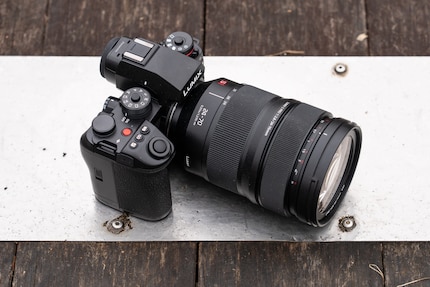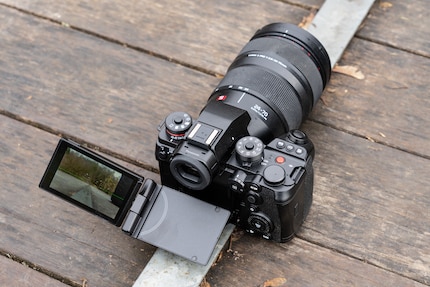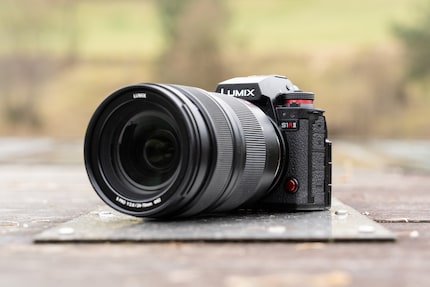

Panasonic Lumix S1RII: Hybrid flagship at a competitive price
The new full-frame flagship from Panasonic offers many features and a new sensor. It is suitable for almost everything, but the competition is fierce.
With the Lumix S1RII, Panasonic is presenting the successor to the S1R from 2019. It is designed to offer top performance at the cutting edge of technology for both photography and video. To this end, Panasonic has installed a new sensor and equipped the S1RII with many professional functions. It will be available from March and will cost 3449 francs or 3599 euros at market launch.

Compared to its predecessor, the camera is around 20 per cent smaller and lighter. The body has roughly the same format as the Panasonic S5II. The new camera also largely adopts the controls from its little sister, with the addition of a dedicated switch between photo and video mode. The most important key data at a glance:
New sensor as a differentiator
Somewhat surprisingly, Panasonic is not using the 60-megapixel sensor in the S1RII that is used in the Leica SL3 and Sony Alpha 7RV. Instead, there is a new, also back-illuminated full-frame CMOS sensor with 44 megapixels.

Source: Samuel Buchmann
The main reason for this is likely to be a faster readout speed. There are no precise details yet. However, a brief comparison (see video below) shows that the S1RII is significantly less susceptible to rolling shutter effects than the Sony Alpha 7RV. And for photographic applications, 44 megapixels is a good balance between depth of detail and file size. The new sensor also clearly sets Panasonic apart, instead of filling old wine into new wineskins.
The S1RII can record videos in 8K resolution at up to 30 frames per second (FPS). As usual with Panasonic, it is possible to film "open gate", i.e. with the full height of the sensor. However, this function will only be available in 8K later via a firmware update. In 4K, 120 FPS is possible - with 1.1x crop. The variety of recording formats is huge, with internal ProRes RAW also available for 5.8K up to 30 FPS. For more details, I recommend the test report by "Gerald Undone".
In its presentation, the manufacturer emphasises the high video dynamic range of 14 f-stops. The ISO range extends from 80 to 51,200 and can be extended downwards to ISO 40 and upwards to ISO 102,400. Only tests under laboratory conditions will show how well the sensor performs compared to other models. The benchmarks in this segment are the Canon EOS R5 Mark II, the Nikon Z8 and the Sony Alpha 7RV.
Good autofocus, high continuous shooting speed
Panasonic's hybrid autofocus system with phase detection is used for focussing. It has been further improved since its introduction in the S5II and now fluently recognises bodies, faces and eyes - or other subjects such as animals, cars, motorbikes, trains and planes.
The maximum continuous shooting speed with electronic shutter and 12-bit RAW is a very fast 40 FPS. With a mechanical shutter and 14-bit it is 9 FPS. The S1RII is also capable of pre-release recording. It can be set in three stages from 0.5 to 1.5 seconds.
The built-in image stabiliser optically compensates for camera shake by up to eight f-stops. There is also a new digital stabilisation called "Active I.S.", which is intended to ensure video recordings like on a gimbal. This works without cropping because it also utilises the area of the sensor that lies outside of the normal video resolution.

Source: Samuel Buchmann
The display on the back can be tilted, folded out and rotated. It has a resolution of 1.84 million pixels. With a 3-inch diagonal, it is slightly smaller than the competitor models, whose screens are 3.2 inches in size. The resolution of the electronic viewfinder is 5.76 million pixels - more than the Nikon Z8, the same as the Canon R5 Mark II and less than the Sony Alpha 7RV.
Packed with features
When it comes to software features, Panasonic tries to set itself apart from other manufacturers. The S1RII incorporates everything that the brand has developed and refined in recent years.
Ambitious filmmakers, for example, will appreciate the ability to record 32-bit float audio via the optional XLR adapter. This format can capture a larger volume spectrum. This makes recording less complicated and can allow more leeway in post-production. Put simply, float audio is the sound equivalent of a RAW file. However, you need a very good microphone to make it really work.
The new "Cinelike A2" video colour profile is designed to offer a high dynamic range, but requires less effort to grade than classic log profiles. In addition to Zebra and Peaking, Panasonic is expanding the display arsenal with "False Colour", which colours the image according to brightness levels.
In the photo area, there is the familiar high-resolution mode: using sensor shift, eight images are taken one after the other and then merged into a single image directly in the camera. This quadruples the resolution to 177 megapixels. The mode also works handheld, but at least the image content should be as static as possible.
First conclusion: very good, but the competition is powerful
If you've been waiting for a new full-frame camera from Panasonic, you're in for a treat. The S1RII makes a thoroughly solid impression in the first hands-on test. It is likely to find a loyal following among filmmakers in particular - partly because of the top-level video quality and partly because of the many professional functions. The S1RII is also a good overall package in the photography sector, but does not stand out from the competition.

Source: Samuel Buchmann
In general, Panasonic is operating in a highly competitive segment with the new flagship. The Canon EOS R5 Mark II and the Nikon Z8 offer stacked sensors that enable even faster autofocus. They remain the better choice for action and sports photography. And those looking for the most portable overall system with high resolution will find the larger range of compact lenses at Sony and will probably continue to opt for the Alpha 7RV.
The Panasonic Lumix S1RII falls right in between. Its 44-megapixel BSI sensor can be read out faster than one with a higher resolution. And it is likely to have a better dynamic range than stacked sensors. Depending on your priorities, this may be exactly the right compromise for an all-round camera. Another argument in Panasonic's favour: even at market launch, the price of the S1RII is lower than the street price of the three other hybrid flagships from Nikon, Sony and Canon.
My fingerprint often changes so drastically that my MacBook doesn't recognise it anymore. The reason? If I'm not clinging to a monitor or camera, I'm probably clinging to a rockface by the tips of my fingers.
From the latest iPhone to the return of 80s fashion. The editorial team will help you make sense of it all.
Show all